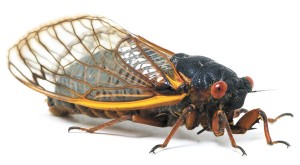INDIANA — According to Purdue Agricultural Extension, the state of Indiana will see the emergence of 17-year locusts, or periodical cicadas beginning in the latter part of May. Designated “Brood X,” this is the largest of the broods that hatch in the United States, and Indiana will be the epicenter of the emergence. Billions of the insects will emerge within a six-week period.
The insects are about 1 ½-2 inches long and are black with reddish legs and eyes. You will hear their loud shrill calls (made by the male) before you see them. They appear in heavily wooded areas, where they lay their eggs in the twigs of woody plants before dying. In about six weeks, the eggs hatch and the nymphs fall to the ground and dig into the soil, feeding off sap from tree roots. In 17 years, they will emerge and the cycle begins again.
The emergent cicadas provide a feast for birds, raccoons, and squirrels. However, when there is a large brood such as the 2021 Brood X, wildlife alone cannot control their numbers. In certain areas, the carcasses of the cicadas will make a big mess on roadways and sidewalks. Cicadas in large numbers can also damage young trees in wood lots and orchards when the female slits open twigs to lay her eggs. They lay their eggs in over 200 types of trees and are common on oak, hickory, and fruit trees.
Small trees and shrubs can be protected by covering them with ½” mesh fabric for the six weeks the adult cicadas are present. The use of pesticides is not as effective, and the pesticides that kill cicadas also kill beneficial insects such as bees and will likely create a spider mite problem for the rest of the year.
Despite their size, cicadas are harmless to humans. Pets, however, may eat the carcasses if given the chance. The sound of lawn mowers and weedeaters sounds like their mating call and may attract cicadas to your yard.



